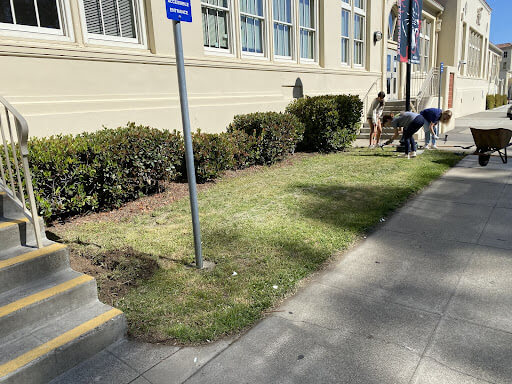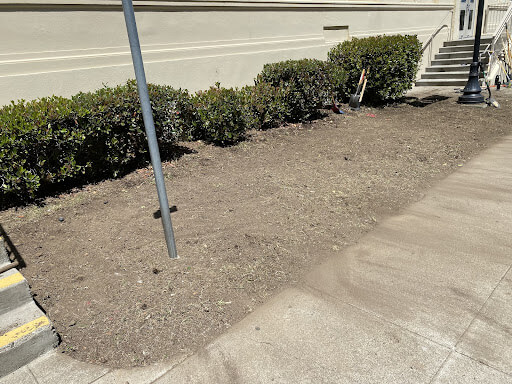This article is part of our Youth Voices series. At Ten Strands we believe that young people have valuable perspectives and a critical role in shaping our society and our world. We recognize their power to drive dialogue and create positive change, and are committed to providing a platform which amplifies their contributions.
(The article was written from the perspective of Olivia Johnson but was a collaboration between all three contributors).
Throughout my life, my parents and other adult figures in my life have instilled in me the understanding that the environment is a place of both sanctity and solace, and that Mother Earth was a magnanimous matriarch, a benevolent overseer of human activity. My childhood was spent wading in the Merced River, trekking in the woods of Washington, and tending to my father’s ever-expanding community garden empire. I was raised with an appreciation for nature and all it provides for humans. As I grew older, I became increasingly aware of the fact that humans were biting the very hand that feeds them (literally and figuratively): our Earth. I had, of course, heard passing comments from relatives, teachers, and the like about the imminent irreversibility of climate change and its effects, the rise in global temperatures, ocean acidification, ozone layer depletion, habitat loss, and the myriad other issues that seem to permeate each and every conversation about the future of our planet. My naivete prevailed in the face of such issues, as I believed them to be “adult issues.” That is, until August 9th of 2021.
The Intergovernmental Panel on Climate Change (IPCC) released a comprehensive assessment of climate science in early August of last year, right before the beginning of my sophomore year. This report delineates the world’s full knowledge pertaining to the physical basis of climate change and identifies human activity to be the unequivocal cause of occurrences like floods and droughts, heatwaves, the melting of polar ice and glaciers, and rising sea levels. My mother, whose job focuses on the intersection between corporate social responsibility/philanthropy and environmentalism, frequently discussed both this intergovernmental body and its recent findings with me. Feeling somewhat obligated to at least read some of the report, I half-heartedly Googled “IPCC report” on an eerily warm night in December. Though much of the terminology was foreign to me, what I was able to comprehend both shocked and frightened me to my very core. For the rest of that month, I dreamed in facts and figures; e.g., that our planet is on course to warm by 1.5℃ in the next two decades, or that approximately 44 percent of 2,700 species living in biodiversity hotspots were found to be at high extinction risk, and about 24 percent at very high extinction risk due to climate change (IPCC, 2021). A week after I read the report, I emailed a local sustainability specialist named Kamille Lang about applying for a program she headed called Youth Climate Ambassadors (YCA).
For the next six months, I attended bimonthly meetings with environmental activists, policy makers, and changemakers with firsthand field work experience. Though their advice and assistance was invaluable, the most exciting and motivating part about YCA were my peers. A network of budding activists, all of whom were driven to advocate and work to generate environmental change in their communities, was truly inspiring for me. It was in such a setting that I was partnered with Emma Gubbels and Zoe Tsai, who would soon become my closest allies in what often felt like an impossible fight: engendering environmental change in our community.
The two main undertakings of the Youth Climate Ambassadors program are a systems analysis project and a community impact project (CIP). The systems analysis project is a month-long research project on an environmental issue of your choice, for which you must propose a solution. For my systems analysis project, I, along with Emma and another young woman in the program, explored and analyzed different waste-processing systems and their effects. For some, the systems analysis project serves as a forerunner to their community impact project. However, for Emma and me, this was not the case. From the get-go, Emma, Zoe, and I knew that we wanted to create a physical model for our CIP. Originally, we hoped to install an on-site composting facility, the products of which (i.e., dirt and mulch) would be used to help us create a small-scale vegetable garden. However, we struggled to gain administrative approval for such a project. Our principal, who greatly assisted us in planning and implementing this project, informed us that there was arsenic in our desired garden plot, throwing a wrench in our plans of creating an edible garden. However, he was very receptive to the idea of creating a native plant and succulent garden, as this meant the dirts’ contamination would not be an issue and creating such a garden would require much less water than a vegetable garden. Thus, we were forced to switch gears.

Though we were a bit frazzled by a change to our original project, this roadblock turned out to be a blessing in disguise. Our group was able to tackle two huge environmental issues, biodiversity loss and poor use of water resources, in one project: a small-scale native plant and succulent garden that replaced a 9-by-30-foot patch of grass on our school’s campus. A large part of the reason we chose to endeavor this project was its topical relevance to our school community, especially administrators, who were concerned about the amount of water being used to help maintain lawns and grass patches on our campus.

To create such a thing, we assembled a motley crew of parent volunteers, students interested in environmentalism, and YCA staffers. With our team of 16, we were able to successfully tear up the grass in our garden plot, dispose of it in organic waste bins, help revitalize the health of our soil by mixing mulch and soil conditioner into the dirt, plant our succulents and California natives, and even add a decorative rock path to our garden.

I measured the success of this project in three ways. First, we can measure success through metrics. Our school had very few plants on campus, so the addition of 5-plus native plant species to our school undoubtedly increased biodiversity on campus. Though we don’t know the exact amount of water the grass patch used previously, we can estimate due to the lawn’s measurements that it required approximately 168 gallons of water per month, while our garden requires less than 50. Second, this garden is a cynosure, a spot of color and life amid a sea of monotone brown buildings. I truly believe having this garden on campus will help students feel more connected to the natural world overall. Last, and perhaps most important, we can measure our success through the educational benefit of our project. The simple act of exposing students to the wonders of native plants and succulents is educational in and of itself. Additionally, throughout our build day, we discussed the importance of bolstering biodiversity, which helped students gain a deeper understanding of why native plants are so critical to creating a diverse, healthy ecosystem. This promoted both environmental literacy and action. After the build day, I had two student volunteers come up to me after we’d finished the project and discuss their intent to join our school’s Environmental Club, and several more say they wanted to look into purchasing California natives or other plants with low water needs. The more support we can garner from the student body, the more we can expand on our original initiative and attempt to generate even greater environmental change in our community. And from the looks of it, the students of Burlingame High School seem eager to help us do just that.



